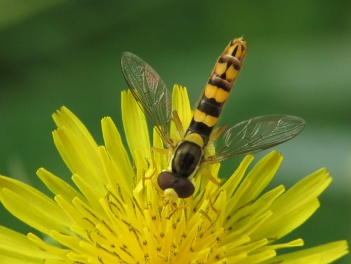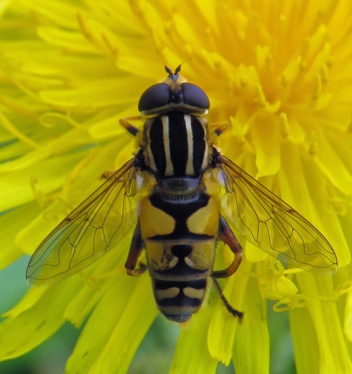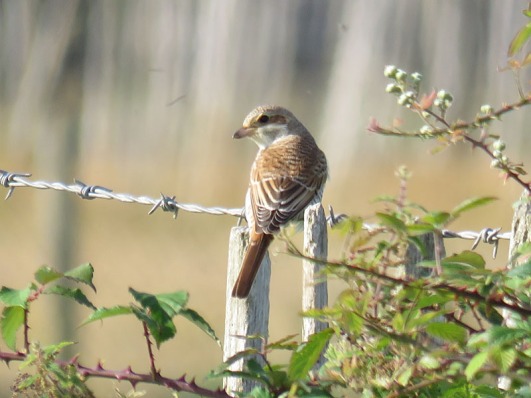So another month has been and indeed gone! I have always had a fondness for October so maybe it will bring good things, who knows I may even be lucky enough to see the very rare Little owl! How I have managed to go nine months without seeing one is a mystery, but I have. Other years I have seen them regularly in our village, we even saw one in a tree in our garden once but not this year.
September has been a good month but nothing major to report on the sightings front. One event that I can’t let go unmentioned is that our grandson, Daniel, began school and what a good time he is having!

We have only added two birds, Pectoral sandpiper and yellow-browed warbler but we have still enjoyed the hunt!
An early event in the month was my first sighting of a frog (I know, where have I been up to now?) closely followed by a toad, literally on our doorstep!
Insects have risen the most this month, largely because there hasn’t been much else to catch my eye! I have had a favourite though, this beautiful beetle. 
I had it miss-identified originally but it turns out to actually be a Rosemary-leaf beetle and is a bit of a thug, I’m glad I resisted the temptation to bring it home with me!!!
I have also learnt this month that a hoverfly isn’t simply a hoverfly there are very many different ones, here are a few I have seen in recent weeks.
We had a lovely visit with Alan and Judy and the weather was just about perfect, if anything it was a tad too hot! They arrived on an evening that had seen rain all day and left the day before the rain returned, but for there stay…not a drop.
Due to my back (I have moaned enough about that previously) my daily tally of steps on my Fitbit had sadly fallen, Alan and Judy’s visit got those steps up again. 
We also snuck a last minute visit in with Janice and Chris, an overnight stop with them at the very end of the month. That was mainly to check up on Chris as it had been his turn to miss-behave in the health department! We had a good time with them and were pleased to find Chris looking, though rather weary, not too far off his usual self. Another reminder of our mortality but also another huge blessing that it had not been worse and we are all still here in more or less sound body and minds (I did say more or less!).
We spent several days in Bedfordshire on pet sitting duties which was very enjoyable. Sadly I forgot to take a picture of the bunnies but here is the rest of the gang.
We got out and about with several walks at RSPB The Lodge and also Danish Camp. We added Pygmy shrew to our mamal list which was a bonus and certainly saw plenty of sign that autumn is heading our way.
Ruth and Stu’s time away had gone well, it was centred around running a half-marthon in Euro Disney! I must be honest here, I feel we got the best end of the deal staying in their home looking after ‘their family’!!! 
I mentioned a flower we saw growing and had wondered what it was.
 Thanks to both James and Christine for letting me know it is Himalayan Balsam which inspite of being an attractive plant is a pest! It spreads like wild fire mainly due to the fact that the seed heads explode and travel great distances.
Thanks to both James and Christine for letting me know it is Himalayan Balsam which inspite of being an attractive plant is a pest! It spreads like wild fire mainly due to the fact that the seed heads explode and travel great distances.
We have continued to regularly see lots of dragonflies and a smaller number of damslelies too. I think the one that pleased me most this month was the one that landed on Alan’s hat! We had seen lots of male banded demoisels but as far as I know this was the first female. I am sure I must have seen them but they are not so conspicuous as thier partners so I guess they simple eluded me.

New moths have continued to appear but not in the numbers that we had last year which has been rather disappointing. I think it has been generally quieter year for them and not due to anything we have done differently. We have picked up some more micro moths this month and I suspect that is pretty much it for the year for them. I will pop a few pictures of some of the micros we have had this year, (not necessarily this month) mostly from our trap but some Peter has shared from his garden.
So another month gone and time to look at lists (or ignore them ) and see how the numbers have slowly grown. Most people that predicted my final tally have been knocked out as it now stands at 698 but there is still a fight on!
Bird List 244
- Mute Swan
- Bewick Swan
- Whooper Swan
- Pink-footed Goose
- White-fronted Goose
- Greylag Goose
- Canada Goose
- Barnacle Goose
- Brent Goose
- Egyptian Goose
- Common Shelduck
- Muscovy duck
- Mandarin Duck
- Eurasian Wigeon
- Gadwall
- Eurasian Teal
- Mallard
- Pintail
- Garganey
- Shoveler
- Red-crested Pochard
- Common Pochard
- Ferruginous Duck *
- Tufted duck
- Greater Scaup
- Common Eider
- Long-tailed Duck
- Common Scoter
- Velvet Scoter
- Goldeneye
- Smew
- Hooded merganser *
- Red-breasted Merganser
- Red Grouse
- Black Grouse
- Goosander
- Red-legged Partridge
- Grey Partridge
- Common Pheasant
- Golden Pheasant
- Little Grebe
- Great Crested Grebe
- Red-necked Grebe *
- Slavonian Grebe
- Black-necked Grebe
- Fulmar
- Manx Shearwater
- Gannet
- Cormorant
- Shag
- Bittern
- Little Egret
- Great Egret
- Grey Heron
- White Stork
- Glossy Ibis
- Spoonbill
- Red Kite
- White-tailed Eagle
- Marsh Harrier
- Hen Harrier
- Pallid Harrier *
- Goshawk *
- Eurasian Sparrowhawk
- Common Buzzard
- Rough-legged Buzzard
- Golden Eagle
- Osprey
- Kestrel
- Merlin
- Hobby
- Peregrine Falcon
- Water Rail
- Corn Crake
- Moorhen
- Western purple swamphen*
- Coot
- Common Crane
- Great bustard *
- Oystercatcher
- Black-winged Stilt
- Pied Avocet
- Stone-curlew
- Little ringed Plover
- Ringed Plover
- Dotterel
- European Golden Plover
- Grey Plover
- Lapwing
- Great Knot*
- Knot
- Sanderling
- Little Stint
- Temminck’s Stint
- Pectoral Sandpiper
- Curlew Sandpiper
- Purple Sandpiper
- Dunlin
- Broad-billed Sandpiper *
- Ruff
- Jack Snipe
- Common Snipe
- Long-billed Dowitcher *
- Woodcock
- Black-tailed Godwit
- Bar-tailed Godwit
- Whimbrel
- Curlew
- Spotted Redshank
- Common Redshank
- Common Greenshank
- Lesser Yellowlegs
- Green Sandpiper
- Wood Sandpiper
- Common Sandpiper
- Ruddy Turnstone
- Grey Phalarope
- Arctic Skua
- Mediterranean Gull
- Little Gull
- Black-headed Gull
- Common Gull
- Lesser Black-backed Gull
- Herring Gull
- Iceland Gull
- Glaucous Gull *
- Great Black-backed Gull
- Kittiwake
- Caspian Tern *
- Sandwich Tern
- Common Tern
- Arctic Tern
- Common Guillemot
- Razorbill
- Black Guillemot
- Puffin
- Rock Pigeon
- Stock Pigeon
- Wood Pigeon
- Collared Dove
- Turtle Dove
- Rose-ringed Parakeet *
- Cuckoo
- Barn Owl
- Tawny Owl
- Short-eared Owl
- Common Swift
- Common Kingfisher
- European Bee-eater *
- Hoopoe
- Wryneck
- Green Woodpecker
- Great Spotted Woodpecker
- Lesser Spotted Woodpecker
- Wood Lark
- Sky Lark
- Shore Lark (horned lark)
- Sand Martin
- Swallow
- Red-rumped Swallow *
- House Martin
- Tree Pipit
- Meadow Pipit
- Rock Pipit
- Water Pipit
- Yellow Wagtail (Grey-headed)
- Grey Wagtail
- Pied Wagtail
- Dipper
- Wren
- Dunnock
- Robin
- Common Nightingale *
- Bluethroat*
- Black Redstart
- Common Redstart
- Whinchat
- Stonechat
- Wheatear
- Ring Ouzel
- Blackbird
- Fieldfare
- Song Thrush
- Redwing
- Mistle Thrush
- Cetti’s Warbler
- Grasshopper Warbler
- Sedge Warbler
- Eurasian Reed Warbler
- Great Reed Warbler*
- Dartford Warbler
- Lesser Whitethroat
- Whitethroat
- Blackcap
- Yellow-browed Warbler
- Wood Warbler
- Common Chiffchaff
- Willow Warbler
- Goldcrest
- Firecrest
- Spotted Flycatcher
- Red-breasted Flycatcher
- Pied Flycatcher
- Bearded Tit
- Long-tailed Tit
- Marsh Tit
- Willow Tit
- Crested Tit *
- Coal Tit
- Blue Tit
- Great Tit
- Nuthatch
- Treecreeper
- Penduline tit *
- Red-backed Shrike
- Great Grey Shrike
- Jay
- Magpie
- Jackdaw
- Rook
- Crow
- Hooded Crow
- Common Raven
- Starling
- House Sparrow
- Tree Sparrow
- Chaffinch
- Brambling
- Serin *
- Greenfinch
- Goldfinch
- Siskin
- Linnet
- Twite
- Lesser Redpoll
- Mealy Redpoll
- Bullfinch
- Hawfinch
- Lapland Longspur
- Snow Bunting
- Yellowhammer
- Cirl Bunting
- Reed Bunting
- Corn Bunting
Dragon and damselflies 17
Dragon flies
Golden banded dragonfly
Keeled skimmer
Migrant hawker
Black-winged skimmer
Scarce chaser
Common darter
Broad-bodied chaser
Southern hawker
Brown hawker
Ruddy darter
Damselflies
Azure damselfly
Common blue damselfly
Large red damselfly
Small red damselfly
Blue-tailed damselfly
Banded demoiselle
Beautiful demoiselle
Insects and other bits and bobs! 84
- Common Wasp
- Ladybird 7 spot
- Ladybird harlequin
- Lacewing green
- Lacewing brown
- Bloody nosed beetle (Timarcha tenebricosa)
- Red tailed Bumble bee
- White tailed Bumble bee
- Honey bee
- Hornet
- Garden snail
- Slug
- Wood ants
- Scottish wood ants
- Mining bees
- Froghopper
- Hawthorn shieldbug
- Two banded longhorn beetle
- Poplar leaf beetle
- Woodlouse
- Earwig
- Earth worm
- Wolf spider
- Green dock beetle
- Green leafhopper
- Bee fly
- Green sawfly
- Dark bush-cricket
- Pantallon bee
- Bee-wolf
- Daddy-long-legs spider
- Ophion obscratus (wasp)
- Cock chaffer
- House spider
- Money spider
- Zebra spider
- Green fly
- Black fly
- Red spider mite
- Red ant
- Helophilus pendulus (Sun (hover) fly)
- Dasysyrphus albostriatus (hover fly)
- Sphaerophoria scripta ( long hoverfly)
- Eupeodes luniger (hoverfly)
- Common field grasshopper
- Meadow grasshopper
- Mottled grasshopper
- Centipede
- Millipede
- Harvestman (Dicranopalpus ramopus)
- Common sexton beetle (Nicrophorus vespilloides)
- Black sexton beetle (Nicrophorus humator)
- Common green shieldbug
- Buff tailed bumble bee
- Southern oak bush cricket
- Pond skaters
- Water boatmen
- Caddisfly
- Bradycellus verbasci (moth trap invader!)
- Common green grasshopper
- Sitona Lepidus (small beetle)
- Nowickia ferox (fly)
- Tachina grossa (bee-face fly!)
- Sargus flavipes-( Yellow-legged Centurion)
- Common Carder Bumblebee
- Garden spider
- Red-legged shieldbug (Pentatoma rufipes)
- Black Kneed Capsid (Blepharidopterus)
- Nigma walckenaeri (little green spider!)
- Ladybird 2 spot
- Birch shield bug
- Eupterx urticae (tiny nettle bug)
- Speckled bush-cricket
- Chrysolina cerealis ( Rainbow leaf beetle )
- Crane fly
- Box shield bug
- Grove snail
- Small black ant (Lasius niger)
- Large black ant (Formica fusca)
- Nemorilla floralis (black and white fly)
- Devil’s coachhorse (Ocypus olens)
- Nursery spider (Pisaura mirabilis)
- Scorpian fly (Panorpa communis)
- Long-winged Conehead
Butterflies 24
Red admiral
Brimstone
Peacock
Small tortoiseshell
Speckled wood
Green-vein white
Orange tip
Small white
Holly blue
Small copper
Small heath
Dark green fritillary
Common blue
Large heath
Small pearl-bordered fritillary
Green hairstreak
Painted lady
Ringlet
Large skipper
Large white
Gatekeeper
Small skipper
Comma
Grayling
Mammal list 23
- Rabbit.
- Stoat
- Hare
- Grey squirrel
- Common seal
- Roe deer
- Red deer
- Muntjak deer
- Sperm whale
- Grey seal
- Otter
- Weasel
- Bank vole
- Fallow deer
- Red squirrel
- Pine marten
- Beaver
- Daubenton’s bat
- Common pipistrelle
- Common shrew
- Water vole
- Hedgehog
- Pygmy shrew
Reptiles & Amphibians 5 (not a lot but better than last month!)
- Grass snake
- Smooth newt
- Common frog
- Common toad
- Slow worm
Moths alphabetised 231
Angle shades
Barred sallow
Barred straw
Barred yellow
Beaded chestnut
Beautiful golden Y
Beautiful hook-tip
Black arches
Black rustic
Blackneck
Blair’s shoulder-knot
Blood-vein
Bordered beauty
Bordered pug
Broad-bordered yellow underwing
Bright-line brown-eye
Brimstone
Brindled beauty
Brindled pug
Brown rustic
Brown-line bright-eye
Brown-spot pinion
Brown-tail
Buff arches
Buff ermine
Buff tip
Burnished brass
Cabbage moth
Canary-shouldered thorn
Centre-barred sallow
Chestnut
Chinese character
Cinnabar
Clay
Clouded border
Clouded drab
Clouded silver
Clouded-bordered brindle
Coast dart
Common carpet
Common emerald
Common footman
Common marbled carpet
Common pug
Common Quaker
Common rustic
Common swift
Common wave
Common wainscot
Copper underwing
Coronet
Coxcomb prominent
Currant pug
Cypress pug
Dark arches
Dark-barred twin-spot carpet
Dark Spectacle
Dark spinach
Dark/grey dagger
Dewick’s plusia
Dingy footman
Dot moth
Dotted chestnut
Double square spot
Double-striped pug
Drinker
Dun-bar
Dusky brocade
Dusky sallow
Dusky thorn
Dwarf cream wave
Ear moth
Early grey
Early moth
Early thorn
Early toothed-stripe
Elephant hawkmoth
Emperor moth
Engrailed
Eyed hawkmoth
Fan-foot
Feathered gothic
Flame shoulder
Flounced rustic
Four-dotted footman
Foxglove pug
Frosted green
Frosted orange
Garden carpet
Garden tiger
Ghost moth
Great prominent
Green-brindled crescent
Green carpet
Green pug
Green silver-lines
Grey pine carpet
Heart and club
Heart and dart
Hebrew character
Herald
Hummingbird hawkmoth
Iron prominent
July highflyer
Knot-grass
Latticed heath
Large emerald
Large nutmeg
Large wainscot
Large yellow underwing
Least black arches
Least carpet
Least yellow underwing
Leopard moth
Lesser cream wave
Lesser broad-bordered yellow underwing
Lesser swallow prominent
Lesser yellow underwing
Light arches
Light brocade
Light emerald
Lilac beauty
Lime hawkmoth
Lime speck pug
Lobster moth
Lunar underwing
Lychnis
Maiden’s blush
Mallow
Map-winged swift
Marbled beauty
Marbled brown
Marbled minor
March moth
Marbled white spot
Miller (caterpillar)
Mottled beauty
Mottled pug
Mottled rustic
Mottled umber
Mouse moth
Muslin
Nutmeg
Nut-tree tussock
Oak beauty
Orange footman
Orange sallow
Orange Swift
Pale brindle beauty
Pale eggar
Pale mottled willow
Pale prominent
Pale tussock
Pale-shouldered brocade
Peach blossom
Pebble hook-tip
Peppered moth
Pine hawkmoth
Pink-barred sallow
Plain golden Y
Poplar grey
Poplar hawkmoth
Powdered Quaker
Purple bar
Red-line Quaker
Red twin-spot carpet
Riband wave
Rosy footman
Rosy rustic
Royal mantle
Ruby tiger
Rustic
Rustic shoulder-knot
Sallow
Scalloped oak
Scarce footman
Scorched wing
Setaceous Hebrew character
Shears
Short-cloaked moth
Shoulder stripe
Shoulder-striped wainscot
Shuttle-shaped dart
Silver Y
Silver-ground carpet
Single-dotted wave
Six-striped rustic
Slender brindle
Small angle shades
Small blood-vein
Small brindled beauty
Small dusty wave
Small fan-foot
Small fan-footed wave
Small Quaker
Small rivulet
Small square-spot
Small yellow wave
Smoky wainscot
Snout
Spectacle
Spinach
Spruce carpet
Square-spot rustic
Straw dot
Straw underwing
Streamer
Swallow prominent
Swallow-tailed moth
Tawny speckled pug
The flame
Treble bar
Treble lines
Triple-spotted pug
Turnip moth
Uncertain
V moth
V Pug
Vapourer
Varied coronet
Vestal
Vine’s rustic
Waved umber
Webb’s wainscot
White ermine
White satin moth
White-point
Willow beauty
Winter moth
Yellow-barred brindle
Yellow shell
Yellow-tail
Micro moths 70
- Apple leaf miner (Lyonetia clerkella)
- Ash-bark Knot-horn (Euzophera pinguis)
- Barred marble (Celypha striana)
- Beautiful china-mark ( Nymphula nitdulata )
- Bee moth ( Aphomia sociella)
- Bird-cherry ermine ( Yponomeuta evonymella )
- Bordered carl (Coptotriche marginea)
- Brown china-mark ( Elophila nymphaeata)
- Brown house moth (Hofmannophila pseudospretella)
- Chequered grass veneer ( Catopria falsella )
- Codling moth (Cydia pomonella)
- Common drill ( Dichrorampha petiverella )
- Common grey (Scoparia ambiguallis)
- Common marble ( Celypha lacunana )
- Common nettle-tap (Anthophila fabriciana)
- Common plume ( Emmelina monodactyla)
- Cyclamen tortrix ( Clepsis spectrana )
- Dawn flat-body (Semioscopis steinkellneriana)
- Diamond- back moth (Plutella xylostella)
- Dingy dowd (Blastobasis adustella)
- Dotted oak knot-horn ( Phycita roborella)
- Double striped tabby ( Hypsopygia glaucinalis )
- Elbow stripe grass-veneer (Agriphila geniculea)
- Elder pearl (Anania coronate)
- Fenland pearl (Anania perlucidalis)
- Florida pink scavenger (Anatrachyntis badia)
- Garden grass-veneer (Chrysoteuchia culmella)
- Garden pebble (Evergestis forficalis)
- Garden rose tortrix ( Acleris variegana )
- Golden argent (Argyresthia goedartella)
- Gold triangle ( Hypsopygia costalis )
- Grass-veneer (Crambus pascuella)
- Horsechestnut leaf miner (Cameraria ohridella)
- Large fruit-tree tortrix ( Archips podana)
- Large Ivy Tortrix (Lozotaenia forsterana)
- Large tabby ( Aglossa pinguinalis)
- Light brown apple moth (Epiphyas postvittana)
- Little grey (Eudonia lacustrara)
- London dowd ( Blastobasis lacticolella)
- Long-horned flat-body ( Carcina quercana )
- Many plumed moth (Aluctia hexadactyla)
- Maple slender (Caloptilia semifascia)
- Marbled orchard tortrix (Hedya nubiferana)
- March tubic (Diurnea fagella)
- Marbled piercer (Cydia splendana)
- Marsh dwarf (lachista alpinella)
- Meal moth (Pyralis farinalis)
- Mother of pearl ( Pleuroptya ruralis )
- Narrow winged grey ( Eudonia angustea)
- New oak slender ( Caloptilia robustella )
- Obscure agg. ( Oegoconia agg. )
- Ox-tongue conch ( Cochylis molliculana )
- Pale straw pearl ( Udea lutealis )
- Privet tortrix (Clepsis consimilana)
- Red-barred tortrix ( Ditula angustiorana )
- Ringed china-mark ( Parapoynx stratiotata )
- Rough-winged conch (Phtheochroa rugosana)
- Rose tabby ( Endotricha flammealis )
- Rusty dot pearl (Udea ferugalis)
- Small grey ( Eudonia mercurella )
- Small magpie (Anania hortulata)
- Spindle ermine (Yponomeuta cagnaglla)
- Sulphur Tubic ( Esperia sulphurella)
- Triple-blotched bell (Notocelia trimaculana)
- White-bodied conch (Cochylis hypridella)
- White-faced tortix (Pandemis cinnamomeana)
- White-shouldered house moth ( Endrosis sarcitrella)
- White-headed Ermel (Paraswammerdamia alibicapitella)
- Yellow-faced bell (Notocella cynosbatella)
- Yellow-spot tortrix (Pseudargyotoza conwagana)
Why some of these lists insist of double spacing I really don’t know, it is most aggravating as it take up even more space than needed. I have tried retyping and all sorts but it makes no difference, sorry!
See you in October 🙂
 The picture shows a little bit of the queue but can you see the lack of women? Why is birding such a male heavy hobby?
The picture shows a little bit of the queue but can you see the lack of women? Why is birding such a male heavy hobby?









































































 Thanks to both James and Christine for letting me know it is Himalayan Balsam which inspite of being an attractive plant is a pest! It spreads like wild fire mainly due to the fact that the seed heads explode and travel great distances.
Thanks to both James and Christine for letting me know it is Himalayan Balsam which inspite of being an attractive plant is a pest! It spreads like wild fire mainly due to the fact that the seed heads explode and travel great distances.








































 We walked down to the beach and the sea seemed to be as far away as it could possibly be. Add to that the mist situation and we didn’t really see the sea at all!
We walked down to the beach and the sea seemed to be as far away as it could possibly be. Add to that the mist situation and we didn’t really see the sea at all!  We did find this little crab and later on the walk back down the path this snail.
We did find this little crab and later on the walk back down the path this snail.

































 My advice to one and all is, when you get the chance get out in an English Country Garden, big or small they can be a real joy but…don’t follow my sister by going flying with a bang…get well soon Janice!
My advice to one and all is, when you get the chance get out in an English Country Garden, big or small they can be a real joy but…don’t follow my sister by going flying with a bang…get well soon Janice!





























































